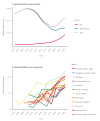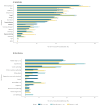Monitoring SARS-CoV-2 variants with complementary surveillance systems: risk evaluation of the Omicron JN.1 variant in France, August 2023 to January 2024
- PMID: 39790077
- PMCID: PMC11719805
- DOI: 10.2807/1560-7917.ES.2025.30.1.2400293
Monitoring SARS-CoV-2 variants with complementary surveillance systems: risk evaluation of the Omicron JN.1 variant in France, August 2023 to January 2024
Abstract
BackgroundEarly detection and characterisation of SARS-CoV-2 variants have been and continue to be essential for assessing their public health impact. In August 2023, Santé publique France implemented enhanced surveillance for BA.2.86 and sub-lineage JN.1 because of their genetic divergence from other variants and increased prevalence.AimTo detail how combining epidemiological and laboratory data sources, targeted investigations and modelling enabled comprehensive characterisation of sub-lineage JN.1.MethodsData were collected from epidemiological investigations using a standardised questionnaire and from routine and novel (RELAB network) surveillance systems. JN.1 cases were compared with cases infected with previously circulating variants, such as EG.5, BA.4/BA.5 and other BA.2.86 sub-lineages. The growth rate and doubling time of JN.1 were estimated.ResultsJN.1 was first detected in September 2023 in the Île-de-France region, France, and spread widely across the country. By late November, doubling time was estimated to be 8.6 to 26.4 days depending on the region. For all data sources, cases infected by JN.1 showed similar demographics, rates of hospitalisation and RT-PCR cycle threshold values compared with those infected by previous variants. JN.1 cases also had older median age (54 years; 40-71 vs 47 years; 30-59), more frequent reports of feverish feeling and less frequent cough or nausea compared with BA.4/BA.5 cases. JN.1 cases had significantly higher frequency of anosmia compared with other BA.2.86 cases.ConclusionCombining different data sources played a key role in detecting emerging variant JN.1, for which no evidence of increased public health impact was found despite its genetic divergence.
Keywords: BA.2.86; COVID-19; JN.1; SARS-CoV-2 variant; genomic surveillance; laboratory network.
Conflict of interest statement
Figures





References
-
- Santé publique France (SpF). Consortium EMERGEN 2023. Paris: SpF. [Accessed: 18 May 2024]. French. Available from: https://www.santepubliquefrance.fr/dossiers/coronavirus-covid-19/consort...
-
- World Health Organization (WHO). BA.2.86 initial risk evaluation of BA.2.86 and its sublineages, 21 November 2023. Geneva: WHO; 2023. Available from: https://www.who.int/docs/default-source/coronaviruse/21112023_ba.2.86_ir...
-
- World Health Organization (WHO). JN.1 Initial Risk Evaluation of JN.1, 19 December 2023. Geneva: WHO; 2023. Available from: https://www.who.int/docs/default-source/coronaviruse/18122023_jn.1_ire_c...
MeSH terms
Supplementary concepts
LinkOut - more resources
Full Text Sources
Medical
Miscellaneous
